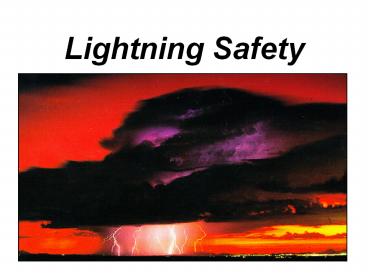Lightning Safety PowerPoint PPT Presentation
1 / 21
Title: Lightning Safety
1
Lightning Safety
2
Lightning Facts
2nd Leading Cause of Weather Deaths in the United
States
- Kills more than Hurricanes and Tornadoes
combined! - Kills 100 / Year
- Kills 10 of those Struck
3
Lightning Facts
- Survivors are an even greater tragedy!
- Injures 750 / Year
- 70 Long-Term Medical Problems
- 30 Suffer Debilitating Problems
- Elusive Data
- 40 - 70 Under-Reported
4
Lightning Facts
When thunderstorms nearby, avoid these activities
like your life depends on it -- It Does!
5
Lightning Safety when Outdoors
- If you can see lightning or hear thunder,
activate your safety plan. Resume activities
only when lightning and thunder have not been
observed for thirty minutes. - If you can see it (lightning), flee it if you
can hear it (thunder), clear it.
6
Lightning Safety
- 30 / 30 Rule
- If 30 Secs Or Less Flash To Bang- Seek
Shelter - COMMON MISCONCEPTION
- 1 second 1 mile
- ACTUALLY
- 5 seconds 1 mile
- Wait 30 Min After Last Lightning, Before
Leaving Shelter - May Seem Too Conservative--Its NOT!
7
Lightning Safety
- Important Components Of A Dispersal/Safety Plan
- Designated individual responsible to monitor the
weather and initiate the necessary precautions
when appropriate. - Procedure identified to notify all personnel of
the appropriate actions when there is a threat or
risk of lightning. - Safer locations must be pre-identified along
with a means to route personnel to those
locations. - Establishment of an All Clear signal which is
differentiated from the warning signal. - Periodically Review / Train / Drill Dispersal
Plan
8
Associated Hazards
- Contrary to commonbelief, most lightning
accidents do not come from direct lightning
strikes. - There are several ways lightning can cause
injury. - COMMUNICATION
9
Tactical Communication
- Equipment will be grounded IAW grounding
instructions contained in applicable TMs.
Remember that soil type impacts the grounding. - Keep away from antennas, masts, guy wires and all
grounding and lightning protection equipment,
including ground rods, during electrical storm
activity. This includes vehicles with whip
antennas.
10
Tactical Communication
- If mission permits, disconnect the signal inputs
before the storm. Do not attempt this during the
storm, even if lightning is not nearby! - Restrict the use of telephones, computers and
other electrical devices. Lightning could follow
the wire. Most lightning injuries occur from
using phones during electrical storms. - Radios will not be used, nor will troops carry
radios with antennas extended.
11
Lightning Step Voltage
200,000 Volts
Step Voltage
Current flow thru earth generates voltage
8,000 volts across feet (Typical)
0 Volts far away
12
(No Transcript)
13
(No Transcript)
14
Safe Locations 1
- No place is absolutely safe from lightning.
Ideally, evacuation to a lightning certified or
lightning protected building is the best when
available however, this will probably not be the
case. - THEN
- Large enclosed structures (substantially
constructed buildings).
15
Indoor Lightning Safety
- Avoid using telephone (remember the wires).
- Avoid using water sink, tub, etc. (plumbing)
- Unplug appliances (remember the wires).
- Inner rooms the best
16
Safe Locations 2
- Fully enclosed metal vehicles car, bus, etc.
- Close windows
- Keep hands on lap
- Its not the rubber tires that make a vehicle
safe its the metal enclosure.
Not Canvas Type (soft) Tops
17
Safe Locations 3
- Remaining Outdoors
- Stay away from rivers, lakes, or other bodies of
water. Be aware of the potential for flooding in
low-lying areas. - Stay away from natural lightning rods/tall
structures such as towers, tall trees, telephone
poles/lines, tents with metal supports, etc. - Take shelter under a small tree among several
large ones if possible. Stay at least six feet
away from the tree trunk to minimize a side
strike and step voltage. NEVER stand under an
isolated tree.
18
Safe Locations 3 (cont)
- Stay low (crouch) in a ditch or depression.
Other options include a low area, ravine, or foot
of a hill. DO NOT lie flat on ground. - Weapons should be stacked at least 50 meters away
from personnel. - Miles gear and other metal conductors should be
removed.
19
Lightning Safety Position (LSP)
- Assume LSP.
- Crouch with feet as close together as possible.
Have heels touch. - Place hands over ears.
- -REMEMBER- DO NOT LIE FLAT ON
THE GROUND
20
Lightning Safe Locations
- Seek Proper Shelter
- Buildings Much Better Than Vehicles
- Large, Fully Enclosed, Substantially Built
- Vehicles Offer Some Safety
- No Place Outside Is Safe Near A
Thunderstorm - Near ? 6 Miles
21
Lightning Safety Websites
- NOAA Lightning Safety
- http//www.lightningsafety.noaa.gov/

